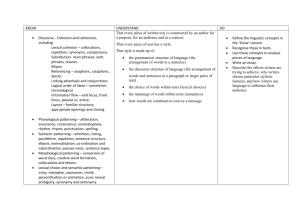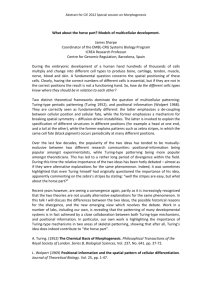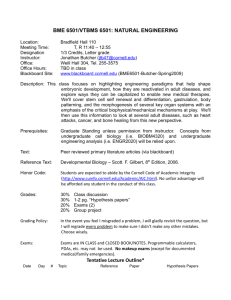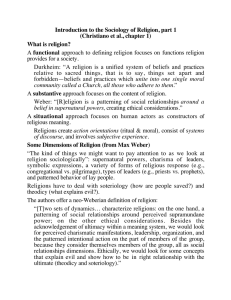Cellular/Tissue Engineering Patterning the Cellular Microenvironment Johns Hopkins University School of Medicine
advertisement
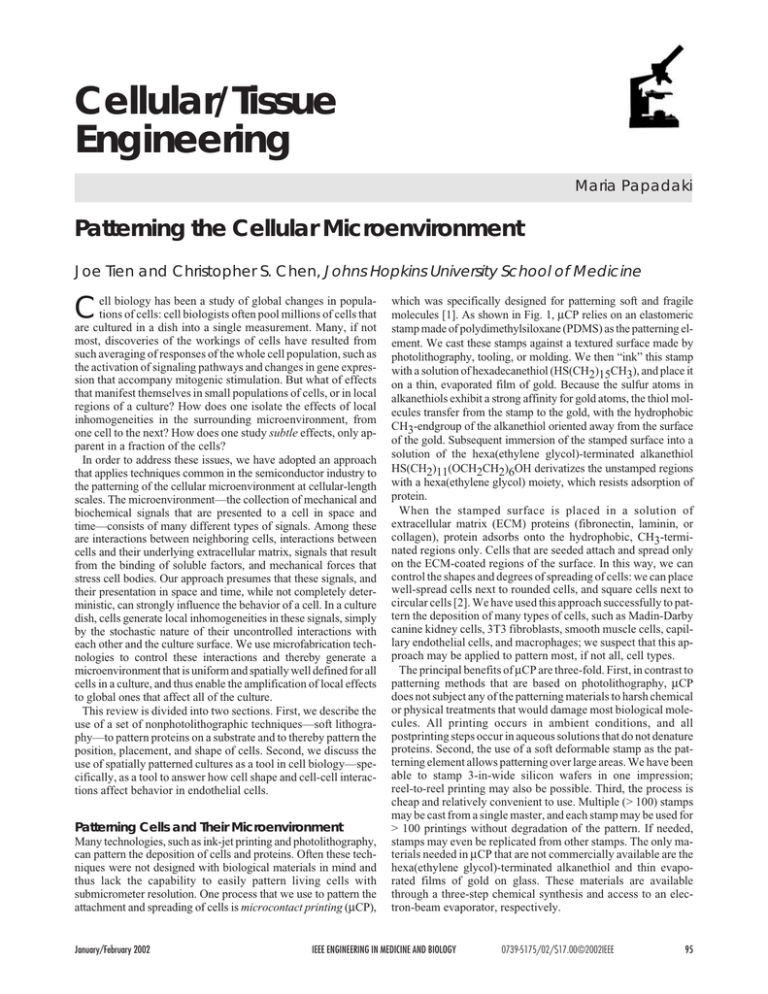
Cellular/Tissue Engineering Maria Papadaki Patterning the Cellular Microenvironment Joe Tien and Christopher S. Chen, Johns Hopkins University School of Medicine ell biology has been a study of global changes in populations of cells: cell biologists often pool millions of cells that are cultured in a dish into a single measurement. Many, if not most, discoveries of the workings of cells have resulted from such averaging of responses of the whole cell population, such as the activation of signaling pathways and changes in gene expression that accompany mitogenic stimulation. But what of effects that manifest themselves in small populations of cells, or in local regions of a culture? How does one isolate the effects of local inhomogeneities in the surrounding microenvironment, from one cell to the next? How does one study subtle effects, only apparent in a fraction of the cells? In order to address these issues, we have adopted an approach that applies techniques common in the semiconductor industry to the patterning of the cellular microenvironment at cellular-length scales. The microenvironment—the collection of mechanical and biochemical signals that are presented to a cell in space and time—consists of many different types of signals. Among these are interactions between neighboring cells, interactions between cells and their underlying extracellular matrix, signals that result from the binding of soluble factors, and mechanical forces that stress cell bodies. Our approach presumes that these signals, and their presentation in space and time, while not completely deterministic, can strongly influence the behavior of a cell. In a culture dish, cells generate local inhomogeneities in these signals, simply by the stochastic nature of their uncontrolled interactions with each other and the culture surface. We use microfabrication technologies to control these interactions and thereby generate a microenvironment that is uniform and spatially well defined for all cells in a culture, and thus enable the amplification of local effects to global ones that affect all of the culture. This review is divided into two sections. First, we describe the use of a set of nonphotolithographic techniques—soft lithography—to pattern proteins on a substrate and to thereby pattern the position, placement, and shape of cells. Second, we discuss the use of spatially patterned cultures as a tool in cell biology—specifically, as a tool to answer how cell shape and cell-cell interactions affect behavior in endothelial cells. C Patterning Cells and Their Microenvironment Many technologies, such as ink-jet printing and photolithography, can pattern the deposition of cells and proteins. Often these techniques were not designed with biological materials in mind and thus lack the capability to easily pattern living cells with submicrometer resolution. One process that we use to pattern the attachment and spreading of cells is microcontact printing (µCP), January/February 2002 which was specifically designed for patterning soft and fragile molecules [1]. As shown in Fig. 1, µCP relies on an elastomeric stamp made of polydimethylsiloxane (PDMS) as the patterning element. We cast these stamps against a textured surface made by photolithography, tooling, or molding. We then “ink” this stamp with a solution of hexadecanethiol (HS(CH2)15CH3), and place it on a thin, evaporated film of gold. Because the sulfur atoms in alkanethiols exhibit a strong affinity for gold atoms, the thiol molecules transfer from the stamp to the gold, with the hydrophobic CH3-endgroup of the alkanethiol oriented away from the surface of the gold. Subsequent immersion of the stamped surface into a solution of the hexa(ethylene glycol)-terminated alkanethiol HS(CH2)11(OCH2CH2)6OH derivatizes the unstamped regions with a hexa(ethylene glycol) moiety, which resists adsorption of protein. When the stamped surface is placed in a solution of extracellular matrix (ECM) proteins (fibronectin, laminin, or collagen), protein adsorbs onto the hydrophobic, CH3-terminated regions only. Cells that are seeded attach and spread only on the ECM-coated regions of the surface. In this way, we can control the shapes and degrees of spreading of cells: we can place well-spread cells next to rounded cells, and square cells next to circular cells [2]. We have used this approach successfully to pattern the deposition of many types of cells, such as Madin-Darby canine kidney cells, 3T3 fibroblasts, smooth muscle cells, capillary endothelial cells, and macrophages; we suspect that this approach may be applied to pattern most, if not all, cell types. The principal benefits of µCP are three-fold. First, in contrast to patterning methods that are based on photolithography, µCP does not subject any of the patterning materials to harsh chemical or physical treatments that would damage most biological molecules. All printing occurs in ambient conditions, and all postprinting steps occur in aqueous solutions that do not denature proteins. Second, the use of a soft deformable stamp as the patterning element allows patterning over large areas. We have been able to stamp 3-in-wide silicon wafers in one impression; reel-to-reel printing may also be possible. Third, the process is cheap and relatively convenient to use. Multiple (> 100) stamps may be cast from a single master, and each stamp may be used for > 100 printings without degradation of the pattern. If needed, stamps may even be replicated from other stamps. The only materials needed in µCP that are not commercially available are the hexa(ethylene glycol)-terminated alkanethiol and thin evaporated films of gold on glass. These materials are available through a three-step chemical synthesis and access to an electron-beam evaporator, respectively. IEEE ENGINEERING IN MEDICINE AND BIOLOGY 0739-5175/02/$17.00©2002IEEE 95 Photoresist Silicon Pour PDMS Prepolymer Cure PDMS Peel Off Stamp Ink with Hexadecanethiol (2 mM in Ethanol) Dry Hexadecanethiol Stamp onto Gold Gold Silicon Applications in Cell Biology Remove Stamp CH3-Terminated Surface Immerse in 2 mM EG-Terminated Thiol in EtOH EG-Terminated Surface Adsorb Fibronectin Fibronectin Seed with Cells 1. Schematic outline of microcontact printing on gold and its use in patterning the attachment of cells. Here, “EG” refers to ethylene glycol. 96 Recently, we have explored the use of other materials in conjunction with µCP to eliminate these last two obstacles that prevent widespread use of the technique. Surfaces that present ethylene glycol groups appear to be unique in their ability to resist protein adsorption and cell attachment in the presence of serum. We and others have found an ethylene oxide-propylene oxide-ethylene oxide copolymer (trade name Pluronics) that can be adsorbed directly onto many conventional materials such as polystyrene and effectively block protein adsorption. Non-(ethylene glycol)-based surface chemistries are being actively examined; whether these surfaces can resist degradation for periods of time in the presence of serum remains to be seen. To pattern the protein directly on a surface, we have used µCP to directly print protein adsorbed onto the stamp, rather than printing alkanethiols onto gold [4]. One can then adsorb the Pluronics onto the unprinted regions of the surface, rendering them inert. This process is simple but has the disadvantage that the protein must be dried onto the stamp before printing it, which can damage the protein. To circumvent this limitation, we have explored using a PDMS membrane as the patterning element. A thin film of PDMS is spun and cured on a patterned master; removal of the PDMS from the master results in a thin PDMS membrane with holes [5]. We then place the membrane on top of a culture dish, adsorb ECM proteins on the dish through the holes in the membrane, remove the membrane, and block nonspecific adsorption of proteins onto the uncoated regions with Pluronics. We can even seed cells directly through the holes in the membrane before removing the membrane [6]. Because the protein is delivered and maintained in an aqueous state, this approach preserves protein activity. A limitation of the use of membranes, however, is that only certain topologies are amenable to this sort of patterning; for instance, donut-shaped islands of ECM protein are difficult to fabricate by using membranes. We have used spatially confined cell cultures to examine the effects of cell shape on behavior of capillary endothelial cells [7, 8]. During morphogenesis, dramatic changes in cell shape appear to correlate with changes in the functional state of the cells. Whether these changes in cell shapes are merely indicative of a functional change in the cell, or instead are partly responsible for the trigger of differentiation, remains hotly debated. Early studies had implicated that growth (proliferation of cells) and apoptosis (programmed death of cells) were regulated by the degree to which cells spread on a surface [9, 10]. The larger the area that a cell occupies on a surface, the more likely the cell appeared to progress through the cell cycle, and the less likely the cell entered the apoptotic program. Though suggestive, these studies could not establish a causal link between cell area and changes in behavior, because cell-ECM contacts correlated proportionally to cell area in these experiments. That is, was the area of cell spreading or the area of cell-ECM contact responsible for causing the growth or death of a cell? With µCP, it was possible to vary cell area and cell-ECM contact area independently. We plated human and bovine capillary endothelial cells onto ECM islands that were arranged as a series of dots [Fig. 2(a)]. Some of these patterns consisted of large dots that were separated by large distances; cells seeded on these patterns attached and spread on one island only, and could not bridge across to another, neighboring island. In this case, the island size determined the total cell area, which was equivalent to the total area of cell-ECM contact. Other patterns consisted of small dots that were separated by small distances; cells seeded on these patterns attached and spread on multiple islands simulta- IEEE ENGINEERING IN MEDICINE AND BIOLOGY January/February 2002 neously, so that the total cell area was several times larger than the Fibronectin total area of cell-ECM contact. By 2000 varying the sizes and separations of dots, we could indirectly change 1000 the cell area or area of cell-ECM contact separately. We found that 0 c h a n g e s in a p o p t ot i c or proliferative rate changed solely 20 with cell area, rather than with area of cell-ECM contact [Fig. 2(b)]. 10 Our studies suggest that cellular 0 regulation through interactions with the ECM do not rely only on 6 the chemical ligation of receptors 4 on the cell membrane. Given the 2 same chemical inputs (the same 0 substrate, proteins, and growth 20:20 5:10 3:6 factors in the media), a cell may al10 µm Circle Diameter:Spacing ter its behavior in response to its (µm) shape. Cellular attachment to the ECM may therefore combine sig(b) (a) naling through chemical factors with mechanical and structural ef2. (a) Capillary endothelial cells that are plated on circular islands of fibronectin bridge fects that result from changes in across multiple islands when the islands are closely spaced. (b) In the three patterns shown cell shape. The nature of this sen(10- m-diameter circles separated by 20 m, 5- m-diameter circles separated by 10 m, sor of shape may consist of couand 3- m-diameter circles separated by 7 m), cells spread to greater extents on the pling between the cytoskeleton smaller islands, although the total cell-ECM contact area remains constant. The and nucleus: in all of our experiproliferative and apoptotic rates correlate with area of cell spreading, rather than with ments, an increase in nuclear area area of cell-ECM contact. (Adapted from [7].) accompanies an increase in cell area, and previous work has indicated that the degree to which a nucleus is spread may determine the pattern of gene expression in that nucleus, perhaps by changing the intranuclear structure. At intermediate cell areas that do not promote cell growth or death, we have found hints of cellular differentiation. Previous work has demonstrated that cultured cells often exhibit differentiated behaviors only when spread to a moderate extent [11]. We have examined this possibility with bovine capillary endothelial cells by plating these cells onto thin (~10 µm wide) lines of ECM protein. On these patterns, cells spread to a moderate degree, and they are also allowed to bind to neighboring cells. Over the course of a week, a fraction of cells appear to detach from the underlying substrate, and rearrange to form “tubes” that possess an inner lumen (Figure 3) . The morphology of these structures appears similar to that of a capillary; currently, we are testing the functionality of these tubes to see if they can support fluid flow. It appears that the unique positioning orientation, and contact of cells with their neighbors and the substrate, provides cues that we still have not unraveled. Apoptosis (%) Growth (%) Area (µm2) Cell Area ECM Contact Area Conclusions 3. (a) Capillary endothelial cells seeded on 10- m-wide lines of fibronectin are moderately spread (area ~ 1000 m2) and form tube-like structures. (b) Cell seeded on 30- m-wide lines of fibronectin are well-spread (area ~ 2200 m2), and do not form tubes. Cells are labeled with a cytoplasmic dye. (Adapted from [8].) January/February 2002 Our adaptation of microfabrication techniques to cell culture enabled the formation of spatially well-defined cultures, with which we could address specific questions regarding the role of spatial presentation of adhesion in cell behavior. These techniques have submicrometer resolution and may be applied to localize signals with subcellular spatial resolution. We are also developing techniques to vary the microenvironment of a cell with time. This set of techniques will enable further fundamental studies in cell biology and expand the range of tools with which we can manipulate and control cell behavior. IEEE ENGINEERING IN MEDICINE AND BIOLOGY 97 Acknowledgments We acknowledge the financial support of the NIGMS (GM60692), the Office of Naval Research, and the Whitaker Foundation. Address for Correspondence: Christopher S. Chen, Department of Biomedical Engineering, Johns Hopkins University School of Medicine, 720 Rutland Avenue, Traylor 718, Baltimore, MD 21205. Tel: +1 410 614 8624. Fax: +1 410 955 0549. E-mail: cchen@bme.jhu.edu. References [1] A. Kumar, H.A. Biebuyck, and G. M. Whitesides, “Patterning self-assembled monolayers: Applications in materials science,” Langmuir, vol. 10, pp. 1498-1511, 1994. [2] R. Singhvi, A. Kumar, G. Lopez, G.N. Stephanopoulos, D.I.C. Wang, and G.M. Whitesides, “Engineering cell shape and function,” Science, vol. 264, pp. 696-698, 1994. [3] C. Roberts, C.S. Chen, M. Mrksich, V. Martichonok, D.E. Ingber, and G.M. Whitesides, “Using mixed self-assembled monolayers presenting RGD and (EG)30H groups to characterize long-term attachment of bovine capillary endothelial cells to surfaces,” J. Am. Chem. Soc., vol. 120, pp. 6548-6555, 1998. 98 [4] J.L. Tan, J. Tien, and C.S. Chen, “Microcontact printing of proteins on mixed self-assembled monolayers,” Langmuir, vol. 18, pp. 519-523, 2002. [5] R.J. Jackman, D.C. Duffy, O. Cherniavskaya, and G.M. Whitesides, “Using elastomeric membranes as dry resists and for dry lift-off,” Langmuir, vol. 15, pp. 2973-2984, 1999. [6] E. Ostuni, R. Kane, C.S. Chen, D.E. Ingber, and G.M. Whitesides, “Patterning mammalian cells using elastomeric membranes,” Langmuir, vol. 16, pp. 7811-7819, 2000. [7] C.S. Chen, M. Mrksich, S. Huang, G.M. Whitesides, and D.E. Ingber, “Geometric control of cell life and death,” Science, vol. 276, pp. 1425-1428, 1997. [8] L.E. Dike, C.S. Chen, M. Mrksich, J. Tien, G.M. Whitesides, and D.E. Ingber, “Geometric control of switching between growth, apoptosis, and differentiation during angiogenesis using micropatterned substrates,” In Vitro Cell. Dev. Biol. Anim., vol. 35, pp. 441-448, 1999. [9] J. Folkman and A. Moscona, “Role of cell shape in growth control,” Nature, vol. 273, pp. 345-349, 1978. [10] D.E. Ingber and J. Folkman, “Mechanochemical switching between growth and differentiation during fibroblast growth factor-stimulated angiogenesis in vitro: role of extracellular matrix,” J. Cell Biol., vol. 109, pp. 317-330, 1989. [11] N. Boudreau, Z. Werb, and M.J. Bissell, “Suppression of apoptosis by basement membrane requires three-dimensional tissue organization and withdrawal from the cell cycle,” Proc. Natl. Acad. USA, vol. 93, pp. 35093513, 1996. IEEE ENGINEERING IN MEDICINE AND BIOLOGY January/February 2002
